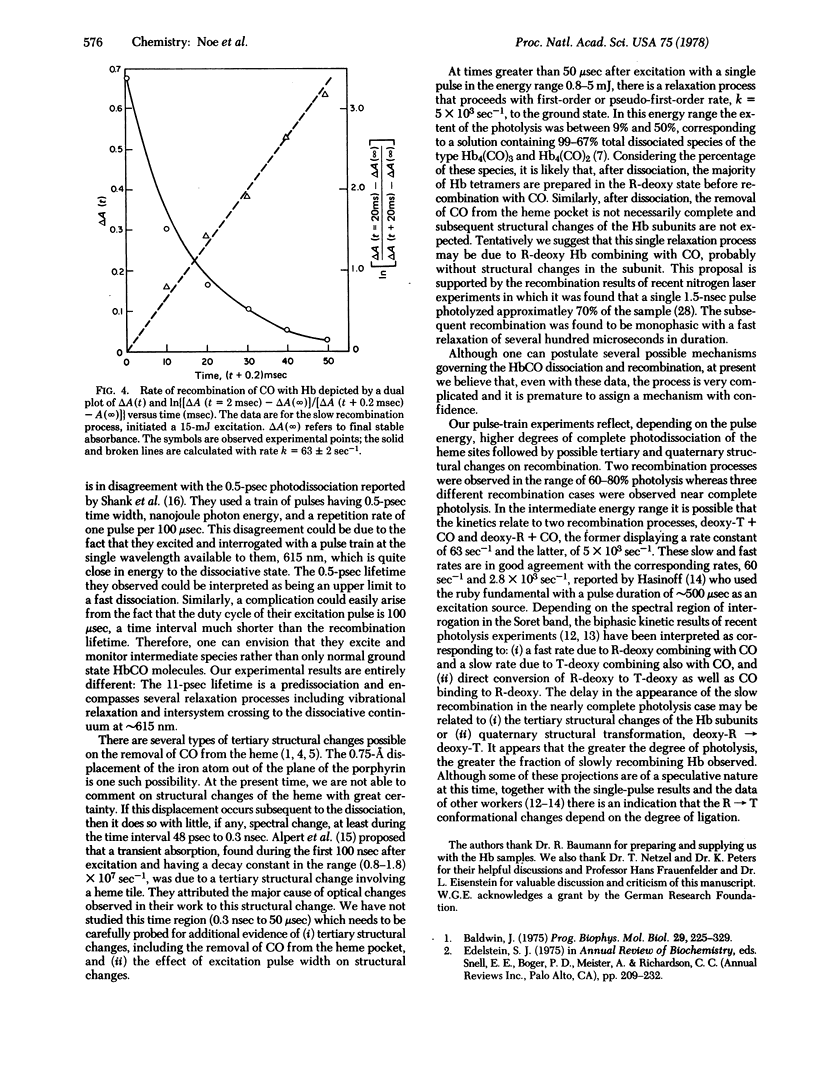Abstract
Excitation of HbCO by a single 6-psec 530-nm pulse results in photodissociation with a first-order constant of 0.89 X 10(11) sec-1. The kinetics of photodissociation, monitored by following absorbance changes in the Soret band at 440 nm, are interpreted as corresponding to predissociation followed by a corssing into a dissociative state. Subsequent recombination of CO with the porphyrin system and protein structural transformations were monitored by use of a continuous He-Cd laser beam spatially coincident with the photolysis and Soret interrogation beams at the sample. We find that the latter events take place in three distinct time regions, depending on exciation pulse energy and repetition rate. Exictation of HbCO with a single pulse (0.8--5 mJ) results in a relaxation to the ground state with an associative first-order constant of 5 X 10(3) sec-1. With a 100-pulse train (approximately 7.5 mJ), a new decay grows with a rate constant of 63 sec-1. For a pulse-train energy of 12 mJ or higher, a delay occurs at the onset of the second (slower) recombination.
Full text
PDF




Selected References
These references are in PubMed. This may not be the complete list of references from this article.
- Alpert B., Banerjee R., Lindqvist L. The kinetics of conformational changes in hemoglobin, studied by laser photolysis. Proc Natl Acad Sci U S A. 1974 Feb;71(2):558–562. doi: 10.1073/pnas.71.2.558. [DOI] [PMC free article] [PubMed] [Google Scholar]
- Alpert B., Lindqvist L. Porphyrin triplet state probing the diffusion of oxygen in hemoglobin. Science. 1975 Mar 7;187(4179):836–838. doi: 10.1126/science.1114327. [DOI] [PubMed] [Google Scholar]
- Antonini E., Anderson N. M., Brunori M. Properties of the product of partial photodissociation of carbon monoxide hemoglobin. J Biol Chem. 1972 Jan 10;247(1):319–321. [PubMed] [Google Scholar]
- Austin R. H., Beeson K. W., Eisenstein L., Frauenfelder H., Gunsalus I. C. Dynamics of ligand binding to myoglobin. Biochemistry. 1975 Dec 2;14(24):5355–5373. doi: 10.1021/bi00695a021. [DOI] [PubMed] [Google Scholar]
- Baldwin J. M. Structure and function of haemoglobin. Prog Biophys Mol Biol. 1975;29(3):225–320. doi: 10.1016/0079-6107(76)90024-9. [DOI] [PubMed] [Google Scholar]
- Bauer C., Pacyna B. The conversion of trivalent to divalent iron in hemoglobin of various species. Anal Biochem. 1975 May 12;65(1-2):445–448. doi: 10.1016/0003-2697(75)90531-x. [DOI] [PubMed] [Google Scholar]
- GIBSON Q. H. The direct determination of the velocity constant of the reaction Hb4 (CO)3 + CO-Hb4(CO)4. J Physiol. 1956 Oct 29;134(1):123–134. doi: 10.1113/jphysiol.1956.sp005628. [DOI] [PMC free article] [PubMed] [Google Scholar]
- GIBSON Q. H. The photochemical formation of a quickly reacting form of haemoglobin. Biochem J. 1959 Feb;71(2):293–303. doi: 10.1042/bj0710293. [DOI] [PMC free article] [PubMed] [Google Scholar]
- Geraci G., Parkhurst L. J., Gibson Q. H. Preparation and properties of alpha- and beta-chains from human hemoglobin. J Biol Chem. 1969 Sep 10;244(17):4664–4667. [PubMed] [Google Scholar]
- Gibson Q. H., Antonini E. Observations on rapidly reacting hemoglobin. J Biol Chem. 1967 Oct 25;242(20):4678–4681. [PubMed] [Google Scholar]
- Gray R. D. Quaternary structure of partially liganded intermediates of sheep carbon monoxide hemoglobin at alkaline pH. J Biol Chem. 1975 Jan 25;250(2):790–792. [PubMed] [Google Scholar]
- Hasinoff B. B. Kinetic activation volumes of the binding of oxygen and carbon monoxide to hemoglobin and myoglobin studied on a high-pressure laser flash photolysis apparatus. Biochemistry. 1974 Jul 16;13(15):3111–3117. doi: 10.1021/bi00712a017. [DOI] [PubMed] [Google Scholar]
- MONOD J., WYMAN J., CHANGEUX J. P. ON THE NATURE OF ALLOSTERIC TRANSITIONS: A PLAUSIBLE MODEL. J Mol Biol. 1965 May;12:88–118. doi: 10.1016/s0022-2836(65)80285-6. [DOI] [PubMed] [Google Scholar]
- May R. P., Mayer A. On the pH-dependence of the reaction of hemoglobin with carbon monoxide. Eur J Biochem. 1975 Apr 1;52(3):589–593. doi: 10.1111/j.1432-1033.1975.tb04030.x. [DOI] [PubMed] [Google Scholar]
- McCray J. A. Oxygen recombination kinetics following laser photolysis of oxyhemoglobin. Biochem Biophys Res Commun. 1972 Apr 14;47(1):187–193. doi: 10.1016/s0006-291x(72)80027-5. [DOI] [PubMed] [Google Scholar]
- Muirhead H., Cox J. M., Mazzarella L., Perutz M. F. Structure and function of haemoglobin. 3. A three-dimensional fourier synthesis of human deoxyhaemoglobin at 5.5 Angstrom resolution. J Mol Biol. 1967 Aug 28;28(1):117–156. doi: 10.1016/s0022-2836(67)80082-2. [DOI] [PubMed] [Google Scholar]
- Perutz M. F. Stereochemistry of cooperative effects in haemoglobin. Nature. 1970 Nov 21;228(5273):726–739. doi: 10.1038/228726a0. [DOI] [PubMed] [Google Scholar]
- Sawicki C. A., Gibson Q. H. Quaternary conformational changes in human hemoglobin studied by laser photolysis of carboxyhemoglobin. J Biol Chem. 1976 Mar 25;251(6):1533–1542. [PubMed] [Google Scholar]
- Schmelzer U., Steiner R., Mayer A., Nedetzka T., Fasold H. On the kinetics of the reaction of hemoglobin with CO. Flash-photolysis experiments. Eur J Biochem. 1972 Feb;25(3):491–497. doi: 10.1111/j.1432-1033.1972.tb01720.x. [DOI] [PubMed] [Google Scholar]
- Shank C. V., Ippen E. P., Bersohn R. Time-resolved spectroscopy of hemoglobin and its complexes with subpicosecond optical pulses. Science. 1976 Jul 2;193(4247):50–51. doi: 10.1126/science.935853. [DOI] [PubMed] [Google Scholar]


